
| Version | Summary | Created by | Modification | Content Size | Created at | Operation |
|---|---|---|---|---|---|---|
| 1 | Chenyue Liang | -- | 2070 | 2023-07-25 14:39:49 | | | |
| 2 | Lindsay Dong | Meta information modification | 2070 | 2023-07-26 06:30:17 | | |
Video Upload Options
The Jiao-Liao-Ji Belt (JLJB) is the most representative Paleoproterozoic orogenic belt in the North China Craton (NCC). The sedimentation, metamorphism and magmatism of the Ji’an Group and associated granites provide significant insights into the tectonic evolution of the JLJB. The rock assemblages indicate a transformation of the tectonic environment from a passive margin to an active continental margin following the onset of plate convergence and subduction. The A2-type gneissic granite (Qianzhuogou pluton) is formed in a subsequent back-arc basin extension setting at 2.20–2.14 Ga. The Ji’an Group was finally deposited in an active continental margin during the closure of a back-arc basin at 2.14–2.0 Ga. Then, the sediments were involved in a continent–arc–continent collision between the Longgang and Nangrim blocks at ~1.95 Ga. This process was accompanied by HP granulite-facies metamorphism at ~1.90 Ga. The subsequent exhumation and regional extension resulted in decompression melting during 1.90–1.86 Ga, producing metamorphism with an isothermal decompression clockwise P–T path. The resulting metapelites are characterized by perthite + sillimanite, and mafic granulites are characterized by orthopyroxene + clinopyroxene.
1. Introduction
2. Geological Background

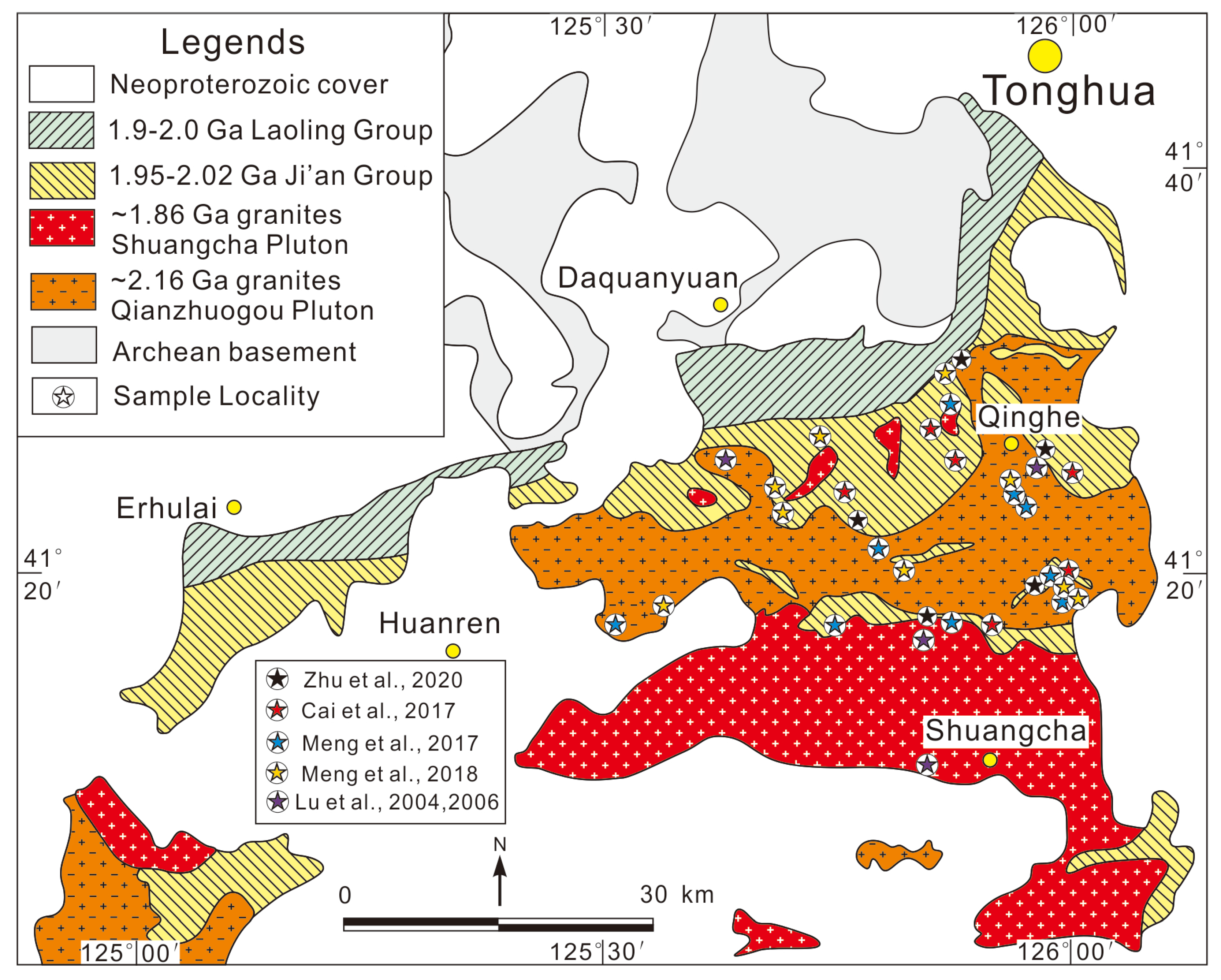
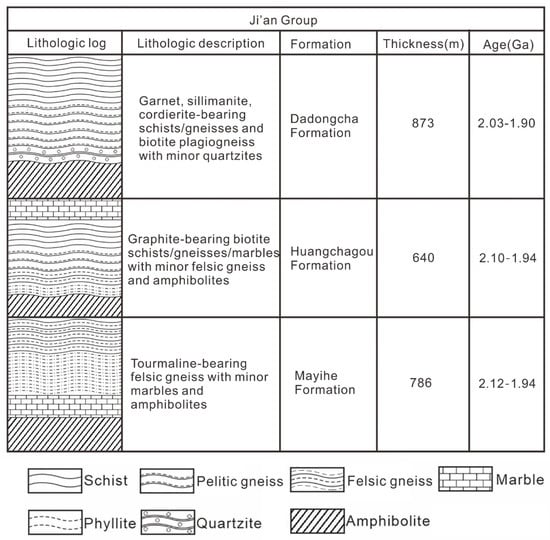
3. Representative Petrography and Microstructures
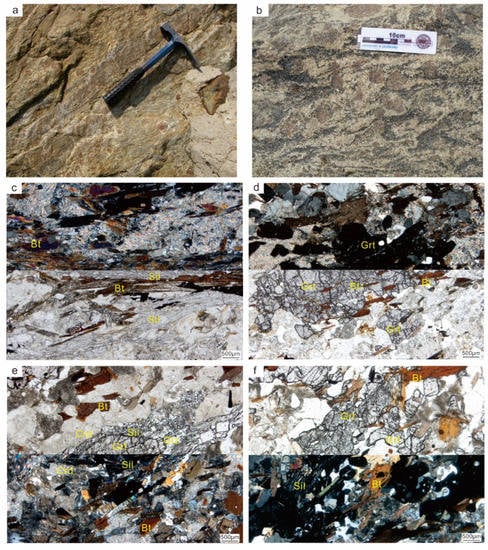
4. Metamorphic Evolution of the Ji’an Group
4.1. Peak Stage
4.2. Retrograde Stage
4.3. P–T Paths
5. Geochemistry of the Ji’an Group
5.1. Meta-Igneous Rocks
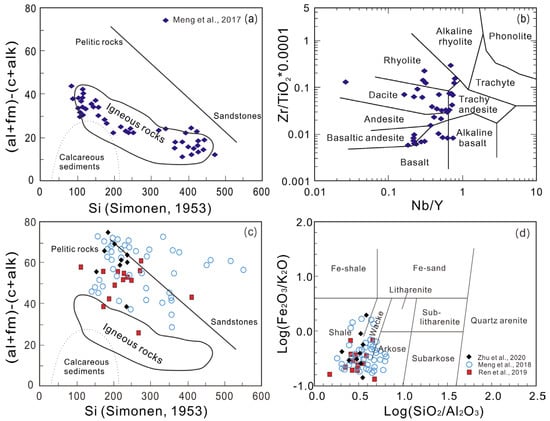
5.2. Metasedimentary Rocks
6. Geochronology of the Ji’an Group and Related Granites
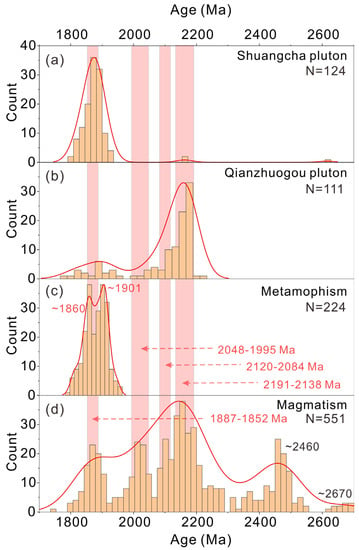
References
- Hoffman, P.F. United Plates of America, The Birth of a Craton: Early Proterozoic Assembly and Growth of Laurentia. Annu. Rev. Earth Planet. Sci. 1988, 16, 543–603.
- Roberts, N.M.W. The boring billion?—Lid tectonics, continental growth and environmental change associated with the Columbia supercontinent. Geosci. Front. 2013, 4, 681–691.
- Zhao, G.; Cawood, P.A.; Wilde, S.A.; Sun, M. Review of global 2.1–1.8 Ga orogens: Implications for a pre-Rodinia supercontinent. Earth-Sci. Rev. 2002, 59, 125–162.
- Faure, M.; Trap, P.; Lin, W.; Monié, P.; Bruguier, O. The formation of the North China Craton by two Palaeoproterozoic continental collisions in Lüliang-Hengshan-Wutaishan-Fuping massifs. Episodes 2007, 30, 1–12.
- Kusky, T.M.; Li, J. Paleoproterozoic tectonic evolution of the North China Craton. J. Asian Earth Sci. 2003, 22, 383–397.
- Zhao, G.C.; Sun, M.; Wilde, S.A.; Li, S.Z. Late Archean to Paleoproterozoic evolution of the North China Craton: Key issues revisited. Precambrian Res. 2005, 136, 177–202.
- Zhao, G.; Wilde, S.A.; Cawood, P.A.; Lu, L. Thermal Evolution of Archean Basement Rocks from the Eastern Part of the North China Craton and Its Bearing on Tectonic Setting. Int. Geol. Rev. 1998, 40, 706–721.
- Liu, D.Y.; Nutman, A.P.; Compston, W.; Wu, J.S.; Shen, Q.H. Remnants of ≥3800 Ma crust in the Chinese part of the Sino-Korean craton. Geology 1992, 20, 339–342.
- Xu, W.; Liu, F. Geochronological and geochemical insights into the tectonic evolution of the Paleoproterozoic Jiao-Liao-Ji Belt, Sino-Korean Craton. Earth-Sci. Rev. 2019, 193, 162–198.
- Zhao, G.C.; Cawood, P.A.; Li, S.Z.; Wilde, S.A.; Sun, M.; Zhang, J.; He, Y.H.; Yin, C.Q. Amalgamation of the North China Craton: Key issues and discussion. Precambrian Res. 2012, 222–223, 55–76.
- Liu, F.L.; Liu, P.H.; Wang, F.; Liu, C.H.; Cai, J. Progresses and overviews of voluminous meta-sedimentary series within the Paleoproterozoic Jiao–Liao–Ji orogenic/mobile belt, North China Craton. Acta Petrol. Sin. 2015, 31, 2816–2846, (In Chinese with English Abstract).
- Zhai, M.-G.; Santosh, M. The early Precambrian odyssey of the North China Craton: A synoptic overview. Gondwana Res. 2011, 20, 6–25.
- Lee, B.C.; Oh, C.W.; Wang, X. Paleoproterozoic (ca. 1.87–1.69 Ga) arc-related tectonothermal events on northcentral Yeongnam Massif, South Korea and its tectonic implications: Insights from metamorphism, geochemistry and geochronology. Precambrian Res. 2020, 338, 105562.
- Li, Z.; Chen, B.; Yan, X. The Liaohe Group: An insight into the Paleoproterozoic tectonic evolution of the Jiao–Liao–Ji Belt, North China Craton. Precambrian Res. 2019, 326, 174–195.
- Liu, J.; Zhang, J.; Liu, Z.; Yin, C.; Xu, Z.; Cheng, C.; Zhao, C.; Wang, X. Late Paleoproterozoic crustal thickening of the Jiao–Liao–Ji belt, North China Craton: Insights from ca. 1.95–1.88 Ga syn-collisional adakitic granites. Precambrian Res. 2021, 355, 106120.
- Liu, J.; Zhang, J.; Yin, C.; Cheng, C.; Liu, X.; Zhao, C.; Chen, Y.; Wang, X. Synchronous A-type and adakitic granitic magmatism at ca. 2.2 Ga in the Jiao–Liao–Ji belt, North China Craton: Implications for rifting triggered by lithospheric delamination. Precambrian Res. 2020, 342, 105629.
- Liu, P.H.; Liu, F.L.; Tian, Z.-H.; Cai, J.; Ji, L.; Wang, F. Petrological and geochronological evidence for Paleoproterozoic granulite-facies metamorphism of the South Liaohe Group in the Jiao-Liao-Ji Belt, North China Craton. Precambrian Res. 2019, 327, 121–143.
- Wang, X.; Oh, C.W.; Lee, B.C.; Liu, F. Paleoproterozoic postcollisional metamorphic and igneous activities in the Jinan area of the Jiao-Liao-Ji Belt in the North China Craton and their tectonic implications. Precambrian Res. 2020, 346, 105793.
- Xu, W.; Liu, F.; Wang, F.; Santosh, M.; Dong, Y.; Li, S. Palaeoproterozoic tectonic evolution of the Jiao–Liao–Ji Belt, North China Craton: Geochemical and isotopic evidence from ca. 2.17 Ga felsic tuff. Geol. J. 2020, 55, 409–424.
- Zhang, W.; Liu, P.; Xu, W.; Tian, Z.; Zhou, W.; Wang, Y.; Zhang, Y.; Wang, W. Petrogenesis and implications of ~2.1 Ga Jingqishan granites in the Jiaobei Terrane, North China Craton. Precambrian Res. 2022, 369, 106536.
- Jahn, B.M.; Liu, D.; Wan, Y.; Song, B.; Wu, J. Archean crustal evolution of the Jiaodong Peninsula, China, as revealed by zircon SHRIMP geochronology, elemental and Nd-isotope geochemistry. Am. J. Sci. 2008, 308, 232–269.
- Lu, X.P.; Wu, F.Y.; Guo, J.H.; Wilde, S.A.; Yang, J.H.; Liu, X.M.; Zhang, X.O. Zircon U–Pb geochronological constraints on the Paleoproterozoic crustal evolution of the Eastern Block in the North China Craton. Precambrian Res. 2006, 146, 138–164.
- Zhou, X.; Zhao, G.; Wei, C.; Geng, Y.; Sun, M. EPMA U-Th-Pb monazite and SHRIMP U-Pb zircon geochronology of high-pressure pelitic granulites in the Jiaobei massif of the North China Craton. Am. J. Sci. 2008, 308, 328–350.
- He, G.P.; Ye, H.W. Two types of Early Proterozoic metamorphism and its tectonic significance in eastern Liaoning and southern Jilin areas. Acta Petrol. Sin. 1998, 14, 152–162, (In Chinese with English Abstract).
- Li, S.Z.; Zhao, G.; Sun, M.; Han, Z.; Luo, Y.; Hao, D.; Xia, X. Deformation history of the Paleoproterozoic Liaohe assemblage in the eastern block of the North China Craton. J. Asian Earth Sci. 2005, 24, 659–674.
- Luo, Y.; Sun, M.; Zhao, G.; Li, S.; Xu, P.; Ye, K.; Xia, X. LA-ICP-MS U–Pb zircon ages of the Liaohe Group in the Eastern Block of the North China Craton: Constraints on the evolution of the Jiao-Liao-Ji Belt. Precambrian Res. 2004, 134, 349–371.
- Bai, J. The Precambrian Geology and Pb–Zn Mineralization in the Northern Margin of North China Platform; Geological Publishing House: Beijing, China, 1993; (In Chinese with English Abstract).
- Faure, M.; Lin, W.; Monie, P.; Bruguier, O. Palaeoproterozoic arc magmatism and collision in Liaodong Peninsula (north-east China). Terra Nova 2004, 16, 75–80.
- Meng, E.N.; Wang, C.-Y.; Li, Z.; Li, Y.-G.; Yang, H.; Cai, J.I.A.; Ji, L.E.I.; Jin, M.-Q. Palaeoproterozoic metasedimentary rocks of the Ji’an Group and their significance for the tectonic evolution of the northern segment of the Jiao–Liao–Ji Belt, North China Craton. Geol. Mag. 2017, 155, 149–173.
- Cai, J.; Liu, F.L.; Liu, P.H.; Wang, F.; Meng, E.; Wang, W.; Yang, H.; Ji, L.; Liu, L.S. Discovery of granulite-facies metamorphic rocks in the Ji’an area, northeastern Jiao–Liao–Ji Belt, North China Craton: Metamorphic P–T, evolution and geological implications. Precambrian Res. 2017, 303, 626–640.
- Zhu, E.L.; Liang, C.Y.; Zheng, C.Q.; Yang, Y.; Zhou, X.; Zhang, Q.; Hu, P.Y. Tectonic evolution of the Dadongcha Formation, Ji’an group, Qinghe area, Tonghua, NE China: Implications from geochronological and geochemical evidence of metapelites. Precambrian Res. 2020, 350, 105917.
- Douce, A.E.; Johnston, A.D. Phase equilibria and melt productivity in the pelitic system: Implications for the origin of peraluminous granitoids and aluminous granulites. Contrib. Mineral. Petrol. 1991, 107, 202–218.
- Vielzeuf, D.; Montel, J.M. Partial melting of metagreywackes. Part I. Fluid-absent experiments and phase relationships. Contrib. Mineral. Petrol. 1994, 117, 375–393.
- Meng, E.; Wang, C.Y.; Yang, H.; Cai, J.; Ji, L.; Li, Y.G. Paleoproterozoic metavolcanic rocks in the Ji’an Group and constraints on the formation and evolution of the northern segment of the Jiao-Liao-Ji Belt, China. Precambrian Res. 2017, 294, 133–150.
- Simonen, A. Stratigraphy and sedimentation of the Svecofennidic, Early Archean supracrustal rocks in southwestern Finland. Bull. Geol. Soc. Finl. 1953, 16, 1–64.
- Herron, M.M. Geochemical classification of terrigenous sands and shales from core or log data. J. Sediment. Petrol. 1988, 58, 820–829.
- Lu, X.P.; Wu, F.Y.; Lin, J.Q.; Sun, D.Y.; Zhang, Y.B.; Guo, C.L. Geochronological successions of the Early Precambrian granitic magmatism in southern Liaodong Peninsula and its constraints on tectonic evolution of the North China Craton. Chin. J. Geol. 2004, 39, 123–138, (In Chinese with English Abstract).
- Ren, Y.W.; Wang, H.C.; Chu, H. Geochemistry of the metamorphic Al-rich sedimentary series and its constraint on provenance in the Paleoproterozoic Liao-Ji active belt. Geol. Bull. China 2019, 38, 17.
- Zhang, W.; Liu, F.L.; Cai, J.; Liu, C.H.; Liu, J.H.; Liu, P.H.; Liu, L.S.; Wang, F.; Yang, H. Geochemistry, zircon U-Pb dating and tectonic implications of the Palaeoproterozoic Ji’an and Laoling groups, northeastern Jiao-Liao-Ji Belt, North China Craton. Precambrian Res. 2018, 314, 264–287.
- Qin, Y.; Chen, D.D.; Liang, Y.H.; Zou, C.M.; Zhang, Q.W.; Bai, L.A. Geochronology of Ji’an group in Tonghua Area, Southern Jilin Province: Earth Science. J. China Univ. Geosci. 2014, 39, 1587–1599, (In Chinese with English Abstract).




